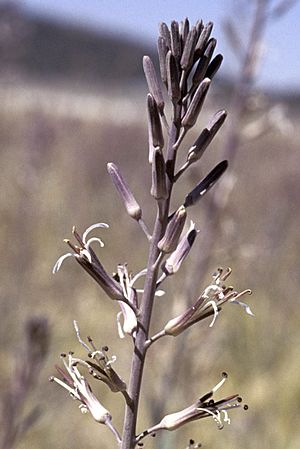Slenderpetal thelypody facts for kids
Quick facts for kids Slenderpetal thelypody |
|
|---|---|
 |
|
| Conservation status | |
| Scientific classification | |
| Genus: |
Thelypodium
|
| Species: |
stenopetalum
|
Thelypodium stenopetalum is a very rare flowering plant. It belongs to the mustard family. People often call it the slenderpetal thelypody or slender-petaled mustard. This plant only grows in the San Bernardino Mountains in southern California. It is found in just a few wet mountain meadows near Big Bear Lake. Because its home is disappearing, this plant is an endangered species in the United States.
What Does This Plant Look Like?
Thelypodium stenopetalum is a plant that lives for two years. It grows stems that can reach about 80 centimeters (about 31 inches) long. These stems branch out and are smooth and waxy. They can be green or purple.
The leaves at the bottom of the plant are thick. They are shaped like long ovals or spears, up to 15 centimeters (about 6 inches) long. Their edges can be smooth or wavy. Leaves higher up on the stem are much smaller. They might wrap around the stem where they attach.
The flowers grow in a tall, open cluster called a raceme. The flowers are spaced far apart. Their petals are usually light purple, but sometimes they are white. The petals are narrow and thin, and sometimes look crinkled. After the flowers, the plant produces long, thin, cylinder-shaped fruits called siliques. These fruits can be up to 5 centimeters (about 2 inches) long.
Where Does This Plant Live?
This plant is in danger because its home, the mountain meadows, is being destroyed. These areas are being used for new buildings and fun activities like hiking. Also, animals grazing and weedy plants that don't belong there are harming the meadows.
Changes in how water flows (called hydrology) and the quality of the soil also hurt the plant. A lot of its original home was lost over a hundred years ago. This happened when the Big Bear Dam was built, which made Big Bear Lake much bigger and flooded nearby land.
Thelypodium stenopetalum sometimes grows near special areas called pebble plains. These areas are also home to several other rare plant species.
This mustard plant is important because it is a food source for the young (larvae) of a rare butterfly. This butterfly is called the Andrew's marble butterfly (Euchloe hyantis andrewsi).


